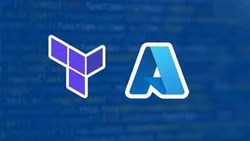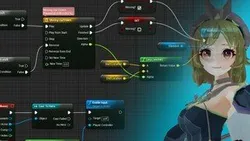
Terraform on Azure - Basic Tutorial 
This course provides an introduction to Terraform on Azure, teaching the fundamentals of building infrastructure as code. Gain the skills to create and manage cloud resources with Terraform on Azure. ▼
ADVERTISEMENT
Course Feature
![]() Cost:
Cost:
Free
![]() Provider:
Provider:
Udemy
![]() Certificate:
Certificate:
No Information
![]() Language:
Language:
English
![]() Start Date:
Start Date:
On-Demand
Course Overview
❗The content presented here is sourced directly from Udemy platform. For comprehensive course details, including enrollment information, simply click on the 'Go to class' link on our website.
Updated in [April 29th, 2023]
Course Overview:
This course will help you to build a basic foundation of Terraform on Azure. You will learn how to install Terraform, set up the environment path, install Visual Studio Code and its extension for Terraform, install Azure Command Line Interface (CLI), authenticate Azure using CLI to perform Terraform Deployment, understand Azure Provider details and how to search template in Terraform Azure Documentation, and execute Terraform init, plan, and apply commands.
Possible Development Directions:
After completing this course, you will have a basic understanding of Terraform and its usage on Azure. You can further develop your skills by exploring more advanced topics such as Terraform modules, Terraform workspaces, and Terraform state management. You can also learn more about the HashiCorp Configuration Language (HCL) and JSON to write more complex Terraform configurations.
Related Learning Suggestions:
To further develop your Terraform skills, you can explore other courses such as Terraform on Azure - Advanced Tutorial, Terraform on AWS - Basic Tutorial, and Terraform on AWS - Advanced Tutorial. You can also read books such as Terraform: Up and Running and Terraform: The Definitive Guide to gain a deeper understanding of Terraform. Additionally, you can join online communities such as the Terraform Community Forum and the Terraform Slack Channel to ask questions and get help from other Terraform users.
[Applications]
After completing this course, users will have a basic understanding of Terraform and how to use it on Azure. They will be able to install Terraform, set up the environment path, install Azure CLI, authenticate Azure, search for templates in the Terraform Azure Documentation, execute Terraform init, plan, apply, and destroy commands, use interpolation and resource blocks, create variables, use local blocks, set up a Terraform remote backend, create output blocks, create data blocks, and create virtual machines. With this knowledge, users will be able to create and manage their own infrastructure on Azure using Terraform.
[Career Paths]
Job Position Paths:
1. Terraform Developer: Terraform Developers are responsible for designing, developing, and deploying cloud-based infrastructure using Terraform. They must have a strong understanding of cloud-based technologies, such as Azure, and be able to write code in HashiCorp Configuration Language (HCL) or JSON. As the demand for cloud-based infrastructure continues to grow, Terraform Developers will be in high demand.
2. Cloud Infrastructure Engineer: Cloud Infrastructure Engineers are responsible for designing, building, and maintaining cloud-based infrastructure. They must have a strong understanding of cloud-based technologies, such as Azure, and be able to use Terraform to deploy and manage cloud-based infrastructure. As the demand for cloud-based infrastructure continues to grow, Cloud Infrastructure Engineers will be in high demand.
3. DevOps Engineer: DevOps Engineers are responsible for automating the deployment and management of cloud-based infrastructure. They must have a strong understanding of cloud-based technologies, such as Azure, and be able to use Terraform to deploy and manage cloud-based infrastructure. As the demand for cloud-based infrastructure continues to grow, DevOps Engineers will be in high demand.
4. Cloud Architect: Cloud Architects are responsible for designing and implementing cloud-based solutions. They must have a strong understanding of cloud-based technologies, such as Azure, and be able to use Terraform to deploy and manage cloud-based infrastructure. As the demand for cloud-based solutions continues to grow, Cloud Architects will be in high demand.
[Education Paths]
Recommended Degree Paths:
1. Bachelor of Science in Computer Science: This degree program provides students with a comprehensive understanding of computer science fundamentals, including programming, software engineering, computer architecture, and operating systems. It also covers topics such as artificial intelligence, machine learning, and data science. This degree is ideal for those interested in developing and managing computer systems and networks.
2. Master of Science in Cloud Computing: This degree program focuses on the design, implementation, and management of cloud computing systems. It covers topics such as cloud architecture, cloud security, cloud storage, and cloud networking. It also provides students with the skills needed to develop and deploy cloud-based applications. This degree is ideal for those interested in working in the cloud computing industry.
3. Master of Science in Data Science: This degree program provides students with the skills needed to analyze and interpret large datasets. It covers topics such as data mining, machine learning, and data visualization. It also provides students with the skills needed to develop and deploy data-driven applications. This degree is ideal for those interested in working in the data science industry.
4. Master of Science in Artificial Intelligence: This degree program provides students with the skills needed to develop and deploy artificial intelligence systems. It covers topics such as machine learning, natural language processing, and computer vision. It also provides students with the skills needed to develop and deploy AI-based applications. This degree is ideal for those interested in working in the AI industry.
Developing Trends:
1. Bachelor of Science in Computer Science: With the increasing demand for computer science professionals, this degree is becoming more popular. As technology advances, the need for computer science professionals with advanced skills is growing.
2. Master of Science in Cloud Computing: Cloud computing is becoming increasingly popular, and the demand for cloud computing professionals is growing. As cloud computing becomes more widely used, the need for professionals with advanced cloud computing skills is increasing.
3. Master of Science in Data Science: Data science is becoming increasingly important, and the demand for data science professionals is growing. As data becomes more widely used, the need for professionals with advanced data science skills is increasing.
4. Master of Science in Artificial Intelligence: Artificial intelligence is becoming increasingly important, and the demand for AI professionals is growing. As AI becomes more widely used, the need for professionals with advanced AI skills is increasing.
Pros & Cons

Excellent explanation, great content, solid understanding, short and nice, easy and clear, awesome.

Could be more detailed, audio quality, poor English, talks too fast.
Course Provider

Provider Udemy's Stats at AZClass
Discussion and Reviews
0.0 (Based on 0 reviews)
Explore Similar Online Courses

Introduction to Blueprints for beginners in Unreal Engine 5

Eocene F - Rocky Mountains w& Rob Thomas & Darrel Cowan

Python for Informatics: Exploring Information

Social Network Analysis

Introduction to Systematic Review and Meta-Analysis

The Analytics Edge

DCO042 - Python For Informatics

Causal Diagrams: Draw Your Assumptions Before Your Conclusions

Whole genome sequencing of bacterial genomes - tools and applications

Terraform Essential Tutorial

Terraform 101


Start your review of Terraform on Azure - Basic Tutorial